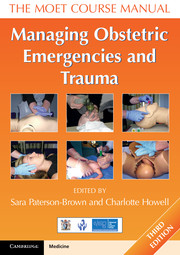Book contents
- Frontmatter
- Dedication
- Contents
- Working Group
- About the authors
- Acknowledgements
- Abbreviations
- Section 1 Introduction
- Section 2 Recognition
- Section 3 Resuscitation
- 8 Airway management and ventilation
- 9 Cardiopulmonary resuscitation in the nonpregnant and pregnant patient
- 10 Amniotic fluid embolism
- 11 Pulmonary thromboembolism
- 12 Resuscitation of the baby at birth
- Section 4 Trauma
- Section 5 Other medical and surgical emergencies
- Section 6 Obstetric emergencies
- Section 7 Triage and transfer
- Section 8 Human issues
- Index
9 - Cardiopulmonary resuscitation in the nonpregnant and pregnant patient
- Frontmatter
- Dedication
- Contents
- Working Group
- About the authors
- Acknowledgements
- Abbreviations
- Section 1 Introduction
- Section 2 Recognition
- Section 3 Resuscitation
- 8 Airway management and ventilation
- 9 Cardiopulmonary resuscitation in the nonpregnant and pregnant patient
- 10 Amniotic fluid embolism
- 11 Pulmonary thromboembolism
- 12 Resuscitation of the baby at birth
- Section 4 Trauma
- Section 5 Other medical and surgical emergencies
- Section 6 Obstetric emergencies
- Section 7 Triage and transfer
- Section 8 Human issues
- Index
Summary
Objectives
On successfully completing this topic, you will be able to:
understand how to perform basic and advanced life support
understand the importance of early defibrillation where appropriate
understand the adaptations of CPR in the pregnant woman.
Introduction and incidence
Cardiac arrest is estimated to occur in every 30 000 deliveries. Both thromboembolism and amniotic fluid embolism are important causes of maternal death, which may present with sudden collapse. It is important that the healthcare teams know the appropriate actions to take in such an event, to improve outcome for both the mother and the child.
Basic life support
Basic life support describes the procedures that a trained lay person could be expected to provide. These include:
• recognising an absence of breathing or other signs of life
• knowing to ask for automated external defibrillator (AED) when summoning help
• performing chest compressions and mouth to mouth or pocket-mask breathing
• (If rescuer not happy to perform mouth to mouth breathing can continue with only chest compressions)
• minimising interruptions to chest compression while using AED.
Advanced life support
Advanced life support describes the procedures that a trained healthcare professional could be expected to provide. This includes all of the above, and in addition:
• the use of airway adjuncts to provide more effective ventilation
• the insertion of intravenous cannulae to give drugs
• the use of semi-automated or manual defibrillators.
- Type
- Chapter
- Information
- Managing Obstetric Emergencies and TraumaThe MOET Course Manual, pp. 109 - 120Publisher: Cambridge University PressPrint publication year: 2014
- 2
- Cited by



